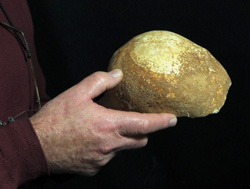By Yotam Rozenwald


JERUSALEM (Tazpit) — A 55,000 year old human skull found at the Dan David-Manot Cave in the western Galilee proves to be of great importance to the study of modern human origins.
The skull is an extremely important finding according to Dr. Omry Barzili, one of the researchers heading the excavation project. “It constitutes the earliest fossilized evidence outside of Africa. It indicates that modern humans originated from Africa, and migrated to other parts of the world,” Barzili told Tazpit News Agency.
The cave and the skull were discovered by accident back in 2008, during an enlargement of the nearby village of Manot. A bulldozer operator involved in laying down sewage infrastructure uncovered the entrance to an active Krastic cave. “After the discovery of the cave Dr. Ofer Madrer examined it and concluded that there are important prehistoric findings in the cave,” Dr. Barzili said.
“The skull was found on a bedrock ledge in the center of the cave. It was covered with cave deposits called ‘flowstone’. We dated the flowstone by means of Uranium-Thorium to 55,000 BC.”
Later on, a morphometric analysis of the skull was made. It concluded that the skull belonged to a modern human being with similarities to modern skulls from Africa on the one hand and the ancient skulls of modern humans from Europe on the other.
Two main hypotheses dominate the research on the origin of modern humans (Homo sapiens). The first claims modern humans originated from an ancient population core, 200,000 years old, from East Africa, which migrated to other parts of the world approximately 100,000 years ago. The second hypothesis claims today’s modern population originated in a later wave of migration that happened some 65,000 years ago.
While the first hypothesis is supported by DNA that was extracted from bones, the second hypothesis lacked fossil evidence. “The skull is the first modern human remains outside of Africa that date back to the period between 65-45 thousand years ago. It is the missing link that validates the claim that modern humans originated from a wave of migration that happened about 65,000 years ago,”Barzili said.
As for the future Barzili thinks the cave can be an interesting site for tourists, “I hope that the cave will be open for the general public sometime in the future. The cave is really beautiful, it contains a central chamber and additional side chambers.”
The cave and its findings have been researched for five years now. It’s a joint project of the Tel Aviv University, Israel Antiquities Authority and Ben-Gurion University of the Negev, headed by Professor Israel Hershkovitz, Dr Omry Barzilai and Dr. Ofer Marder. Many other institutions participated in the research, said Barzili, both Israeli and foreign.
Other institutions participating in study of the cave and its findings includes the Geological Survey of Israel, Weizmann Institute of Science, Hebrew University, University of Haifa, University of Vienna, Harvard University, Case-Western University, Max Planck Institute for Evolutionary Biology, Columbia University and Simon Fraser University.
*
Rozenwald is a staff writer for the Tazpit News Agency.